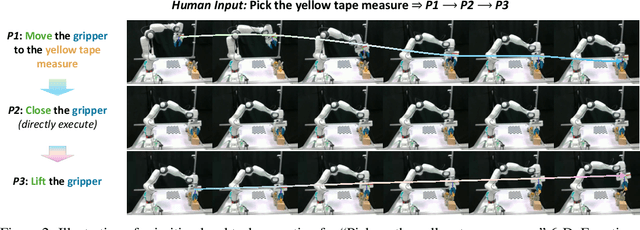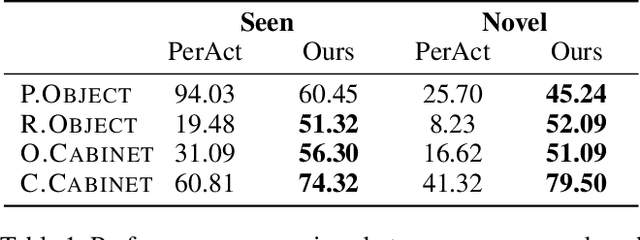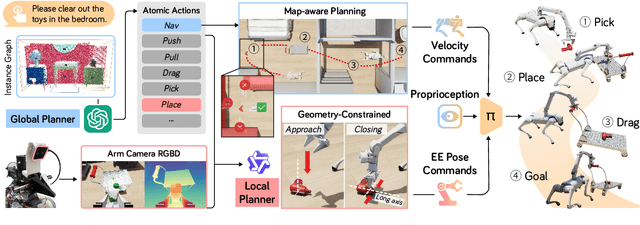Mingyu Liu
StaMo: Unsupervised Learning of Generalizable Robot Motion from Compact State Representation
Oct 06, 2025Abstract:A fundamental challenge in embodied intelligence is developing expressive and compact state representations for efficient world modeling and decision making. However, existing methods often fail to achieve this balance, yielding representations that are either overly redundant or lacking in task-critical information. We propose an unsupervised approach that learns a highly compressed two-token state representation using a lightweight encoder and a pre-trained Diffusion Transformer (DiT) decoder, capitalizing on its strong generative prior. Our representation is efficient, interpretable, and integrates seamlessly into existing VLA-based models, improving performance by 14.3% on LIBERO and 30% in real-world task success with minimal inference overhead. More importantly, we find that the difference between these tokens, obtained via latent interpolation, naturally serves as a highly effective latent action, which can be further decoded into executable robot actions. This emergent capability reveals that our representation captures structured dynamics without explicit supervision. We name our method StaMo for its ability to learn generalizable robotic Motion from compact State representation, which is encoded from static images, challenging the prevalent dependence to learning latent action on complex architectures and video data. The resulting latent actions also enhance policy co-training, outperforming prior methods by 10.4% with improved interpretability. Moreover, our approach scales effectively across diverse data sources, including real-world robot data, simulation, and human egocentric video.
Learning by Imagining: Debiased Feature Augmentation for Compositional Zero-Shot Learning
Sep 16, 2025Abstract:Compositional Zero-Shot Learning (CZSL) aims to recognize unseen attribute-object compositions by learning prior knowledge of seen primitives, \textit{i.e.}, attributes and objects. Learning generalizable compositional representations in CZSL remains challenging due to the entangled nature of attributes and objects as well as the prevalence of long-tailed distributions in real-world data. Inspired by neuroscientific findings that imagination and perception share similar neural processes, we propose a novel approach called Debiased Feature Augmentation (DeFA) to address these challenges. The proposed DeFA integrates a disentangle-and-reconstruct framework for feature augmentation with a debiasing strategy. DeFA explicitly leverages the prior knowledge of seen attributes and objects by synthesizing high-fidelity composition features to support compositional generalization. Extensive experiments on three widely used datasets demonstrate that DeFA achieves state-of-the-art performance in both \textit{closed-world} and \textit{open-world} settings.
Learning Primitive Embodied World Models: Towards Scalable Robotic Learning
Aug 28, 2025



Abstract:While video-generation-based embodied world models have gained increasing attention, their reliance on large-scale embodied interaction data remains a key bottleneck. The scarcity, difficulty of collection, and high dimensionality of embodied data fundamentally limit the alignment granularity between language and actions and exacerbate the challenge of long-horizon video generation--hindering generative models from achieving a "GPT moment" in the embodied domain. There is a naive observation: the diversity of embodied data far exceeds the relatively small space of possible primitive motions. Based on this insight, we propose a novel paradigm for world modeling--Primitive Embodied World Models (PEWM). By restricting video generation to fixed short horizons, our approach 1) enables fine-grained alignment between linguistic concepts and visual representations of robotic actions, 2) reduces learning complexity, 3) improves data efficiency in embodied data collection, and 4) decreases inference latency. By equipping with a modular Vision-Language Model (VLM) planner and a Start-Goal heatmap Guidance mechanism (SGG), PEWM further enables flexible closed-loop control and supports compositional generalization of primitive-level policies over extended, complex tasks. Our framework leverages the spatiotemporal vision priors in video models and the semantic awareness of VLMs to bridge the gap between fine-grained physical interaction and high-level reasoning, paving the way toward scalable, interpretable, and general-purpose embodied intelligence.
Generative Video Matting
Aug 11, 2025Abstract:Video matting has traditionally been limited by the lack of high-quality ground-truth data. Most existing video matting datasets provide only human-annotated imperfect alpha and foreground annotations, which must be composited to background images or videos during the training stage. Thus, the generalization capability of previous methods in real-world scenarios is typically poor. In this work, we propose to solve the problem from two perspectives. First, we emphasize the importance of large-scale pre-training by pursuing diverse synthetic and pseudo-labeled segmentation datasets. We also develop a scalable synthetic data generation pipeline that can render diverse human bodies and fine-grained hairs, yielding around 200 video clips with a 3-second duration for fine-tuning. Second, we introduce a novel video matting approach that can effectively leverage the rich priors from pre-trained video diffusion models. This architecture offers two key advantages. First, strong priors play a critical role in bridging the domain gap between synthetic and real-world scenes. Second, unlike most existing methods that process video matting frame-by-frame and use an independent decoder to aggregate temporal information, our model is inherently designed for video, ensuring strong temporal consistency. We provide a comprehensive quantitative evaluation across three benchmark datasets, demonstrating our approach's superior performance, and present comprehensive qualitative results in diverse real-world scenes, illustrating the strong generalization capability of our method. The code is available at https://github.com/aim-uofa/GVM.
ODYSSEY: Open-World Quadrupeds Exploration and Manipulation for Long-Horizon Tasks
Aug 11, 2025



Abstract:Language-guided long-horizon mobile manipulation has long been a grand challenge in embodied semantic reasoning, generalizable manipulation, and adaptive locomotion. Three fundamental limitations hinder progress: First, although large language models have improved spatial reasoning and task planning through semantic priors, existing implementations remain confined to tabletop scenarios, failing to address the constrained perception and limited actuation ranges of mobile platforms. Second, current manipulation strategies exhibit insufficient generalization when confronted with the diverse object configurations encountered in open-world environments. Third, while crucial for practical deployment, the dual requirement of maintaining high platform maneuverability alongside precise end-effector control in unstructured settings remains understudied. In this work, we present ODYSSEY, a unified mobile manipulation framework for agile quadruped robots equipped with manipulators, which seamlessly integrates high-level task planning with low-level whole-body control. To address the challenge of egocentric perception in language-conditioned tasks, we introduce a hierarchical planner powered by a vision-language model, enabling long-horizon instruction decomposition and precise action execution. At the control level, our novel whole-body policy achieves robust coordination across challenging terrains. We further present the first benchmark for long-horizon mobile manipulation, evaluating diverse indoor and outdoor scenarios. Through successful sim-to-real transfer, we demonstrate the system's generalization and robustness in real-world deployments, underscoring the practicality of legged manipulators in unstructured environments. Our work advances the feasibility of generalized robotic assistants capable of complex, dynamic tasks. Our project page: https://kaijwang.github.io/odyssey.github.io/
Affordance-R1: Reinforcement Learning for Generalizable Affordance Reasoning in Multimodal Large Language Model
Aug 08, 2025Abstract:Affordance grounding focuses on predicting the specific regions of objects that are associated with the actions to be performed by robots. It plays a vital role in the fields of human-robot interaction, human-object interaction, embodied manipulation, and embodied perception. Existing models often neglect the affordance shared among different objects because they lack the Chain-of-Thought(CoT) reasoning abilities, limiting their out-of-domain (OOD) generalization and explicit reasoning capabilities. To address these challenges, we propose Affordance-R1, the first unified affordance grounding framework that integrates cognitive CoT guided Group Relative Policy Optimization (GRPO) within a reinforcement learning paradigm. Specifically, we designed a sophisticated affordance function, which contains format, perception, and cognition rewards to effectively guide optimization directions. Furthermore, we constructed a high-quality affordance-centric reasoning dataset, ReasonAff, to support training. Trained exclusively via reinforcement learning with GRPO and without explicit reasoning data, Affordance-R1 achieves robust zero-shot generalization and exhibits emergent test-time reasoning capabilities. Comprehensive experiments demonstrate that our model outperforms well-established methods and exhibits open-world generalization. To the best of our knowledge, Affordance-R1 is the first to integrate GRPO-based RL with reasoning into affordance reasoning. The code of our method and our dataset is released on https://github.com/hq-King/Affordance-R1.
SDEval: Safety Dynamic Evaluation for Multimodal Large Language Models
Aug 08, 2025Abstract:In the rapidly evolving landscape of Multimodal Large Language Models (MLLMs), the safety concerns of their outputs have earned significant attention. Although numerous datasets have been proposed, they may become outdated with MLLM advancements and are susceptible to data contamination issues. To address these problems, we propose \textbf{SDEval}, the \textit{first} safety dynamic evaluation framework to controllably adjust the distribution and complexity of safety benchmarks. Specifically, SDEval mainly adopts three dynamic strategies: text, image, and text-image dynamics to generate new samples from original benchmarks. We first explore the individual effects of text and image dynamics on model safety. Then, we find that injecting text dynamics into images can further impact safety, and conversely, injecting image dynamics into text also leads to safety risks. SDEval is general enough to be applied to various existing safety and even capability benchmarks. Experiments across safety benchmarks, MLLMGuard and VLSBench, and capability benchmarks, MMBench and MMVet, show that SDEval significantly influences safety evaluation, mitigates data contamination, and exposes safety limitations of MLLMs. Code is available at https://github.com/hq-King/SDEval
VQ-VLA: Improving Vision-Language-Action Models via Scaling Vector-Quantized Action Tokenizers
Jul 01, 2025Abstract:In this paper, we introduce an innovative vector quantization based action tokenizer built upon the largest-scale action trajectory dataset to date, leveraging over 100 times more data than previous approaches. This extensive dataset enables our tokenizer to capture rich spatiotemporal dynamics, resulting in a model that not only accelerates inference but also generates smoother and more coherent action outputs. Once trained, the tokenizer can be seamlessly adapted to a wide range of downstream tasks in a zero-shot manner, from short-horizon reactive behaviors to long-horizon planning. A key finding of our work is that the domain gap between synthetic and real action trajectories is marginal, allowing us to effectively utilize a vast amount of synthetic data during training without compromising real-world performance. To validate our approach, we conducted extensive experiments in both simulated environments and on real robotic platforms. The results demonstrate that as the volume of synthetic trajectory data increases, the performance of our tokenizer on downstream tasks improves significantly-most notably, achieving up to a 30% higher success rate on two real-world tasks in long-horizon scenarios. These findings highlight the potential of our action tokenizer as a robust and scalable solution for real-time embodied intelligence systems, paving the way for more efficient and reliable robotic control in diverse application domains.Project website: https://xiaoxiao0406.github.io/vqvla.github.io
Active-O3: Empowering Multimodal Large Language Models with Active Perception via GRPO
May 27, 2025Abstract:Active vision, also known as active perception, refers to the process of actively selecting where and how to look in order to gather task-relevant information. It is a critical component of efficient perception and decision-making in humans and advanced embodied agents. Recently, the use of Multimodal Large Language Models (MLLMs) as central planning and decision-making modules in robotic systems has gained extensive attention. However, despite the importance of active perception in embodied intelligence, there is little to no exploration of how MLLMs can be equipped with or learn active perception capabilities. In this paper, we first provide a systematic definition of MLLM-based active perception tasks. We point out that the recently proposed GPT-o3 model's zoom-in search strategy can be regarded as a special case of active perception; however, it still suffers from low search efficiency and inaccurate region selection. To address these issues, we propose ACTIVE-O3, a purely reinforcement learning based training framework built on top of GRPO, designed to equip MLLMs with active perception capabilities. We further establish a comprehensive benchmark suite to evaluate ACTIVE-O3 across both general open-world tasks, such as small-object and dense object grounding, and domain-specific scenarios, including small object detection in remote sensing and autonomous driving, as well as fine-grained interactive segmentation. In addition, ACTIVE-O3 also demonstrates strong zero-shot reasoning abilities on the V* Benchmark, without relying on any explicit reasoning data. We hope that our work can provide a simple codebase and evaluation protocol to facilitate future research on active perception in MLLMs.
Omni-R1: Reinforcement Learning for Omnimodal Reasoning via Two-System Collaboration
May 26, 2025Abstract:Long-horizon video-audio reasoning and fine-grained pixel understanding impose conflicting requirements on omnimodal models: dense temporal coverage demands many low-resolution frames, whereas precise grounding calls for high-resolution inputs. We tackle this trade-off with a two-system architecture: a Global Reasoning System selects informative keyframes and rewrites the task at low spatial cost, while a Detail Understanding System performs pixel-level grounding on the selected high-resolution snippets. Because ``optimal'' keyframe selection and reformulation are ambiguous and hard to supervise, we formulate them as a reinforcement learning (RL) problem and present Omni-R1, an end-to-end RL framework built on Group Relative Policy Optimization. Omni-R1 trains the Global Reasoning System through hierarchical rewards obtained via online collaboration with the Detail Understanding System, requiring only one epoch of RL on small task splits. Experiments on two challenging benchmarks, namely Referring Audio-Visual Segmentation (RefAVS) and Reasoning Video Object Segmentation (REVOS), show that Omni-R1 not only surpasses strong supervised baselines but also outperforms specialized state-of-the-art models, while substantially improving out-of-domain generalization and mitigating multimodal hallucination. Our results demonstrate the first successful application of RL to large-scale omnimodal reasoning and highlight a scalable path toward universally foundation models.
 Add to Chrome
Add to Chrome Add to Firefox
Add to Firefox Add to Edge
Add to Edge